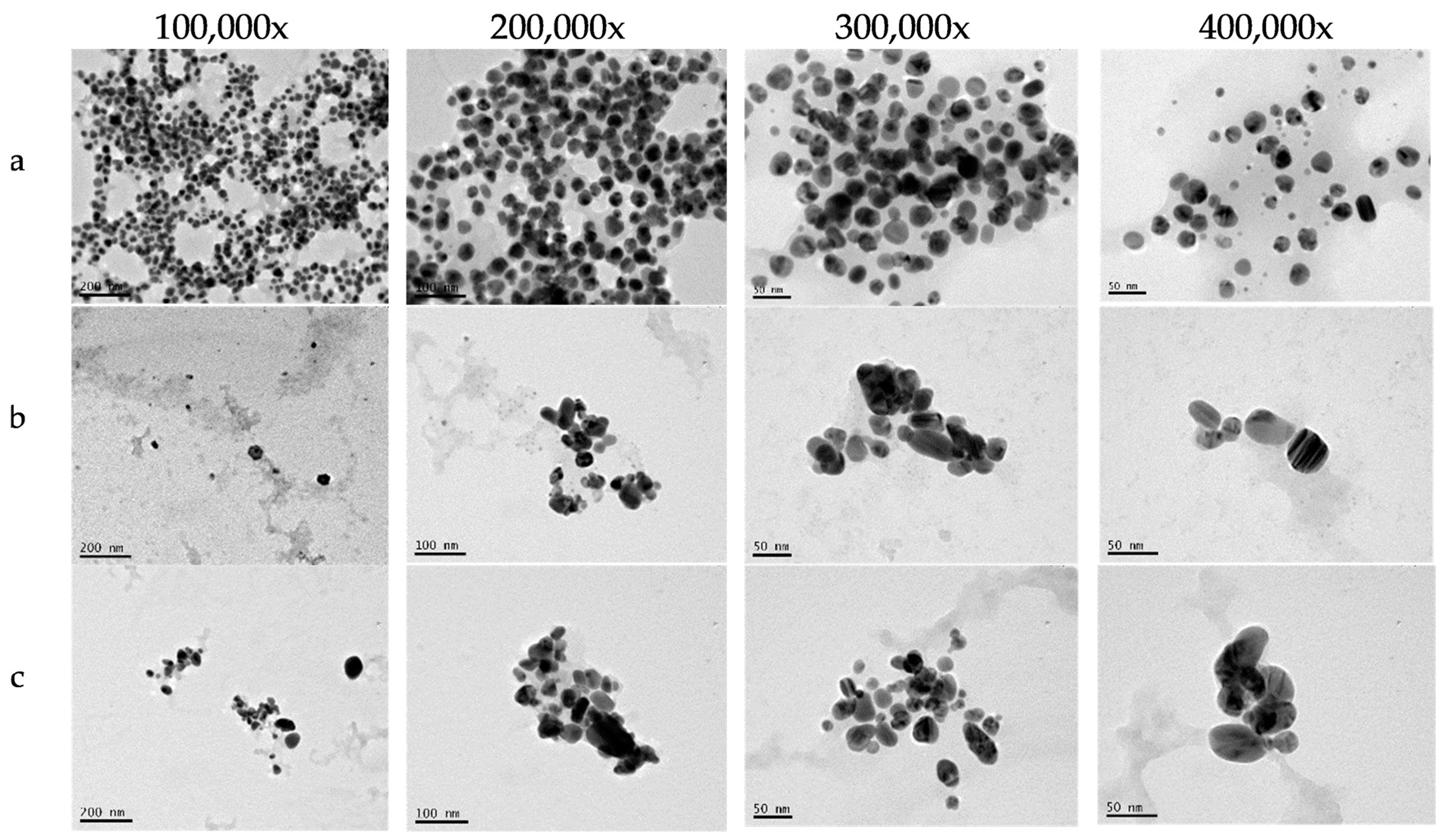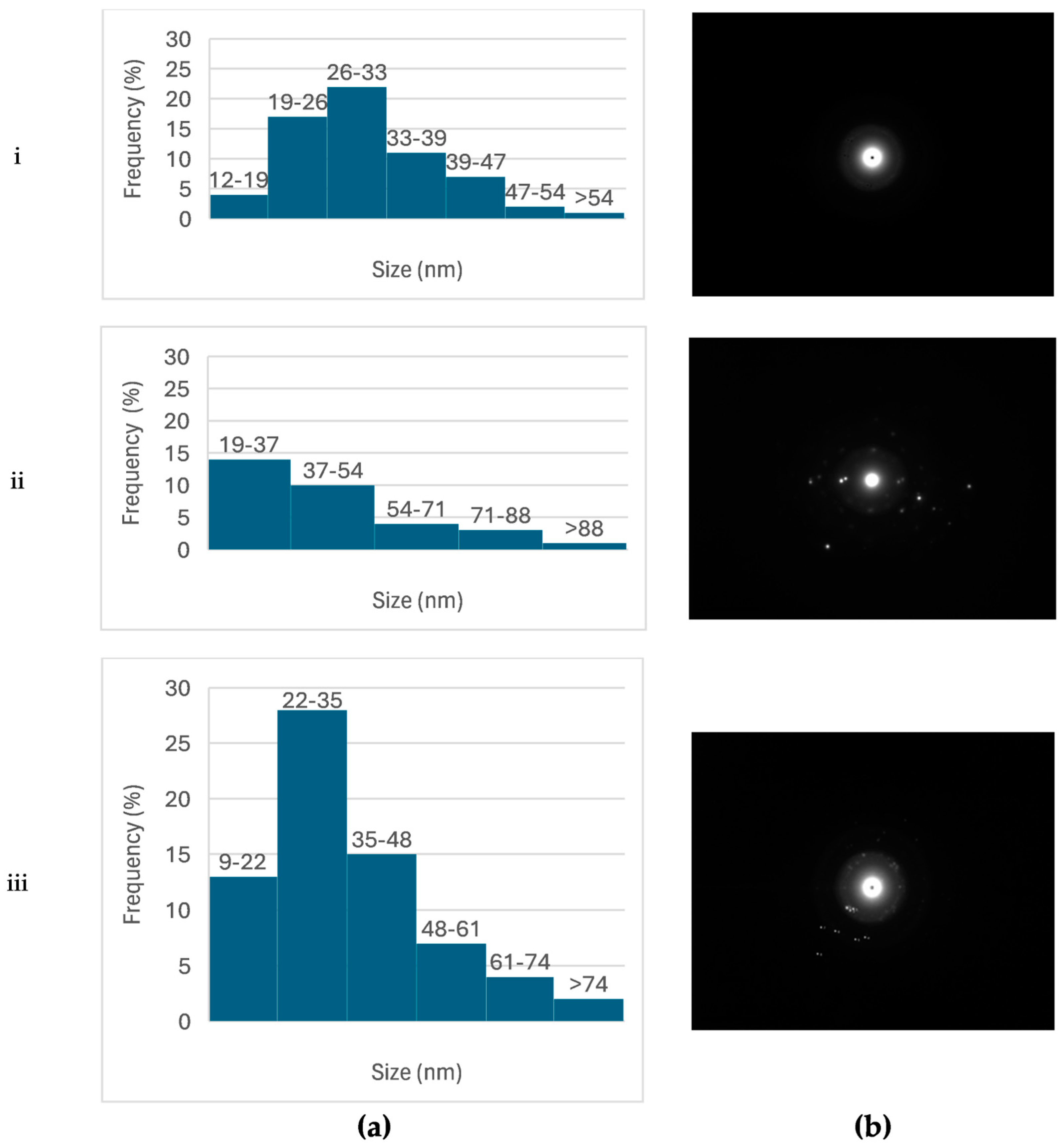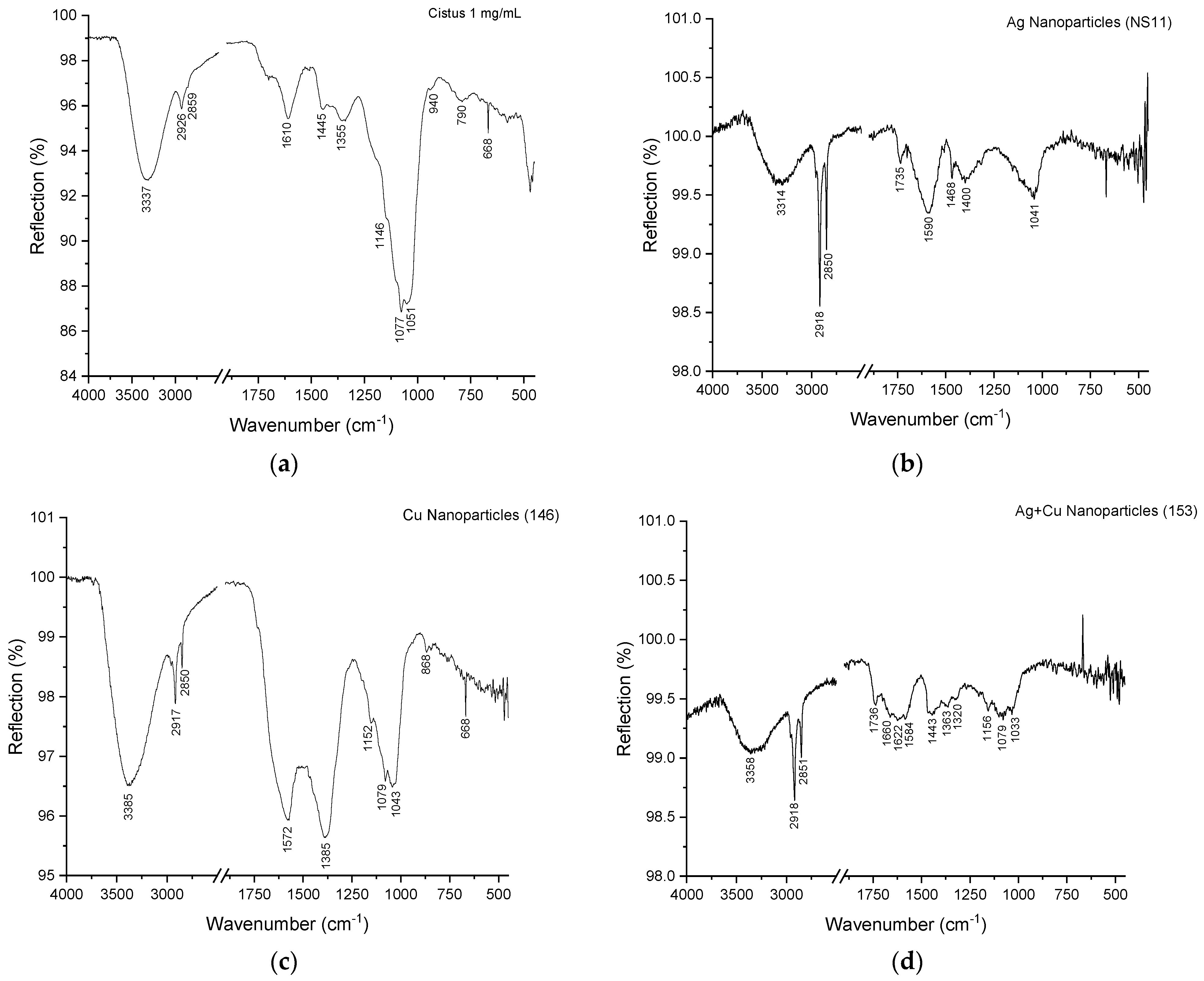Green Synthesis and Comparative Analysis of Silver, Copper Oxide, and Bimetallic Ag/CuO Nanoparticles Using Cistus creticus L. Extract: Physicochemical Properties, Stability, and Antioxidant Potential
Abstract
1. Introduction
2. Results
2.1. Synthesis of NPs Monitored by Spectrophotometry
2.2. Optimization of Experimental Parameters for Nanoparticle Synthesis
2.2.1. Influence of Metal Precursor Concentration on Synthesis of NPs
2.2.2. Role of Extract Concentration in Synthesis of NPs
2.2.3. Imact of pH on Synthesis of NPs
2.2.4. Influence of Stirring Time on Synthesis of NPs
2.3. Physicochemical Characterization of NPs
2.3.1. Size and ζ-Potential
2.3.2. Colloidal Stability of NPs
2.3.3. Morphology of NPs
2.3.4. Crystallinity of NPs
2.3.5. Chemical Composition of NPs
2.4. Antioxidant Activity
3. Discussion
4. Materials and Methods
4.1. Synthesis of NPs
4.1.1. Synthesis of AgNPs
4.1.2. Synthesis of CuONPs Using Cistus creticus L. Extract
4.1.3. Synthesis of Ag/CuONPs Using Cistus creticus L. Extract
4.2. Physicochemical Characterization
4.3. Monitoring of NP Synthesis by Spectrophotometry
4.4. Study of Experimental Parameters for Optimization of Nanoparticle Synthesis
4.4.1. Effect of Metal Precursor Concentration
4.4.2. Effect of Extract Concentration
4.4.3. Effect of pH on Synthesis of NPs
4.4.4. Effect of Stirring Time on Synthesis of NPs
4.5. Stability Study of NPs
4.6. Morphological Characterization of NPs
4.7. Structural, Elemental, and Functional Group Analysis
4.7.1. X-Ray Diffraction (XRD)
4.7.2. Total Reflection X-Ray Fluorescence (TXRF)
4.7.3. Attenuated Total Reflectance–Fourier-Transform Infrared Spectroscopy (ATR-FTIR)
4.8. Evaluation of NPs for Antioxidant Activity
4.9. Statistical Analysis
5. Conclusions
Supplementary Materials
Author Contributions
Funding
Institutional Review Board Statement
Informed Consent Statement
Data Availability Statement
Acknowledgments
Conflicts of Interest
Abbreviations
| Ag | silver |
| CuO | copper oxide |
| NPs | nanoparticles |
| ΤXRF | total X-ray fluorescence |
| DLS | dynamic light scattering |
| ELS | electrophoretic light scattering |
| TEM | transmission electron microscopy |
| SAED | selected area electron diffraction |
| XRD | X-ray diffraction |
References
- Ying, S.; Guan, Z.; Ofoegbu, P.C.; Clubb, P.; Rico, C.; He, F.; Hong, J. Green Synthesis of Nanoparticles: Current Developments and Limitations. Environ. Technol. Innov. 2022, 26, 102336. [Google Scholar] [CrossRef]
- Nie, P.; Zhao, Y.; Xu, H. Synthesis, Applications, Toxicity and Toxicity Mechanisms of Silver Nanoparticles: A Review. Ecotoxicol. Environ. Saf. 2023, 253, 114636. [Google Scholar] [CrossRef]
- Devaraji, M.; Thanikachalam, P.V.; Elumalai, K. The Potential of Copper Oxide Nanoparticles in Nanomedicine: A Comprehensive Review. Biotechnol. Notes 2024, 5, 80–99. [Google Scholar] [CrossRef]
- Shkodenko, L.; Kassirov, I.; Koshel, E. Metal Oxide Nanoparticles against Bacterial Biofilms: Perspectives and Limitations. Microorganisms 2020, 8, 1545. [Google Scholar] [CrossRef] [PubMed]
- Thirumoorthy, G.; Balasubramanian, B.; George, J.A.; Nizam, A.; Nagella, P.; Srinatha, N.; Pappuswamy, M.; Alanazi, A.M.; Meyyazhagan, A.; Rengasamy, K.R.R.; et al. Phytofabricated Bimetallic Synthesis of Silver-Copper Nanoparticles Using Aerva Lanata Extract to Evaluate Their Potential Cytotoxic and Antimicrobial Activities. Sci. Rep. 2024, 14, 1270. [Google Scholar] [CrossRef] [PubMed]
- Khan, I.; Saeed, K.; Khan, I. Nanoparticles: Properties, Applications and Toxicities. Arab. J. Chem. 2017, 12, 908–931. [Google Scholar] [CrossRef]
- Yu, D.-G. Formation of Colloidal Silver Nanoparticles Stabilized by Na+–Poly(γ-Glutamic Acid)–Silver Nitrate Complex via Chemical Reduction Process. Colloids Surf. B Biointerfaces 2007, 59, 171–178. [Google Scholar] [CrossRef]
- Fahimirad, S.; Ajalloueian, F.; Ghorbanpour, M. Synthesis and Therapeutic Potential of Silver Nanomaterials Derived from Plant Extracts. Ecotoxicol. Environ. Saf. 2019, 168, 260–278. [Google Scholar] [CrossRef]
- Adewale Akintelu, S.; Kolawole Oyebamiji, A.; Charles Olugbeko, S.; Felix Latona, D. Green Chemistry Approach towards the Synthesis of Copper Nanoparticles and Its Potential Applications as Therapeutic Agents and Environmental Control. Curr. Res. Green Sustain. Chem. 2021, 4, 100176. [Google Scholar] [CrossRef]
- Kazemi, S.; Hosseingholian, A.; Gohari, S.D.; Feirahi, F.; Moammeri, F.; Mesbahian, G.; Moghaddam, Z.S.; Ren, Q. Recent Advances in Green Synthesized Nanoparticles: From Production to Application. Mater. Today Sustain. 2023, 24, 100500. [Google Scholar] [CrossRef]
- Makarov, V.V.; Love, A.J.; Sinitsyna, O.V.; Makarova, S.S.; Yaminsky, I.V.; Taliansky, M.E.; Kalinina, N.O. “Green” Nanotechnologies: Synthesis of Metal Nanoparticles Using Plants. Acta Naturae 2014, 6, 35–44. [Google Scholar] [CrossRef]
- Barrajón-Catalán, E.; Fernández-Arroyo, S.; Saura, D.; Guillén, E.; Fernández-Gutiérrez, A.; Segura-Carretero, A.; Micol, V. Cistaceae Aqueous Extracts Containing Ellagitannins Show Antioxidant and Antimicrobial Capacity, and Cytotoxic Activity against Human Cancer Cells. Food Chem. Toxicol. 2010, 48, 2273–2282. [Google Scholar] [CrossRef] [PubMed]
- Bouothmany, K.; Bourhia, M.; Aoussar, N.; Attaleb, M.; Salamatullah, A.M.; Nafidi, H.-A.; Mellouki, F.; El Mzibri, M.; Aboul-Soud, M.A.M.; Benbacer, L. Leaf Extracts of Cistus creticus Exhibit Potent Antioxidant and Antiproliferative Activities against Liver, Prostate and Breast Cancer Cells. Appl. Sci. 2022, 12, 8603. [Google Scholar] [CrossRef]
- Florkiewicz, W.; Pluta, K.; Malina, D.; Rudnicka, K.; Żywicka, A.; Guigou, M.D.; Tyliszczak, B.; Sobczak-Kupiec, A. Investigation on Green Synthesis, Biocompatibility, and Antibacterial Activity of Silver Nanoparticles Prepared Using Cistus incanus. Materials 2021, 14, 5028. [Google Scholar] [CrossRef]
- Brindhadevi, K.; Elesawy, B.H.; Elfasakhany, A.; Badruddin, I.A.; Kamangar, S. Wound Dressings Coated with Silver Nanoparticles and Essential Oil of Labdanum. Appl. Nanosci. 2021, 13, 1345–1354. [Google Scholar] [CrossRef]
- Jing, C.; Yan, C.-J.; Yuan, X.; Zhu, L. Biosynthesis of Copper Oxide Nanoparticles and Their Potential Synergistic Effect on Alloxan Induced Oxidative Stress Conditions during Cardiac Injury in Sprague–Dawley Rats. J. Photochem. Photobiol. B-Biol. 2019, 198, 111557. [Google Scholar] [CrossRef] [PubMed]
- Düz, M.; Yakut, Ö. Microwave-Assisted Green Synthesis, Characterization, and Antioxidant Activity of Silver Nanoparticles Using the Aqueous Extract of Cistus creticus. Part. Sci. Technol. 2022, 41, 589–599. [Google Scholar] [CrossRef]
- Siakavella, I.K.; Lamari, F.N.; Papoulis, D.; Orkoula, M.G.; Gkolfi, P.; Lykouras, M.; Avgoustakis, K.; Hatziantoniou, S. Effect of Plant Extracts on the Characteristics of Silver Nanoparticles for Topical Application. Pharmaceutics 2020, 12, 1244. [Google Scholar] [CrossRef]
- Pinto, V.V.; Ferreira, M.J.; Silva, R.; Santos, H.A.; Silva, F.; Pereira, C.M. Long Time Effect on the Stability of Silver Nanoparticles in Aqueous Medium: Effect of the Synthesis and Storage Conditions. Colloids Surf. A Physicochem. Eng. Asp. 2010, 364, 19–25. [Google Scholar] [CrossRef]
- Yugandhar, P.; Vasavi, T.; Uma Maheswari Devi, P.; Savithramma, N. Bioinspired Green Synthesis of Copper Oxide Nanoparticles from SyzygiumAlternifolium (Wt.) Walp: Characterization and Evaluation of Its Synergistic Antimicrobial and Anticancer Activity. Appl. Nanosci. 2017, 7, 417–427. [Google Scholar] [CrossRef]
- Mohammad, M.S.; Shyam, P. Structural Analysis of Biogenic Copper Oxide Nanoparticles, and Their Bio-Activity Assessment. Bionanoscience 2023, 13, 2265–2275. [Google Scholar] [CrossRef]
- Malik, M.A.; Albeladi, S.S.; Al-Maaqar, S.M.; Alshehri, A.A.; Al-Thabaiti, S.A.; Khan, I.; Kamli, M.R. Biosynthesis of Novel Ag-Cu Bimetallic Nanoparticles from Leaf Extract of Salvia officinalis and Their Antibacterial Activity. Life 2023, 13, 653. [Google Scholar] [CrossRef] [PubMed]
- Manjari Mishra, P.; Kumar Sahoo, S.; Kumar Naik, G.; Parida, K. Biomimetic Synthesis, Characterization and Mechanism of Formation of Stable Silver Nanoparticles Using Averrhoa carambola L. Leaf Extract. Mater. Lett. 2015, 160, 566–571. [Google Scholar] [CrossRef]
- Zhan, G.; Huang, J.; Lin, L.; Lin, W.; Emmanuel, K.; Li, Q. Synthesis of Gold Nanoparticles by Cacumen Platycladi Leaf Extract and Its Simulated Solution: Toward the Plant-Mediated Biosynthetic Mechanism. J. Nanoparticle Res. 2011, 13, 4957–4968. [Google Scholar] [CrossRef]
- Chen, K.; Xie, K.; Long, Q.; Deng, L.; Fu, Z.; Xiao, H.; Xie, L. Fabrication of Core–Shell Ag@PDA@HAp Nanoparticles with the Ability for Controlled Release of Ag+ and Superior Hemocompatibility. RSC Adv. 2017, 7, 29368–29377. [Google Scholar] [CrossRef]
- Gudikandula, K.; Metuku, R.P.; Burra, S.; Nidadavolu, S.V.; Pabba, S.K.; Alha, S.C. Fungus-Mediated Synthesis of Silver Nanoparticles and Their Activity against Gram Positive and Gram Negative Bacteria in Combination with Antibiotics. Walailak J. Sci. Technol. 2015, 12, 613–622. [Google Scholar] [CrossRef]
- Bellamy, L.J. The Infra-Red Spectra of Complex Molecules; Methuen and Co., Ltd.: London, UK, 1966. [Google Scholar]
- Silverstein, R.M.; Bassler, G.C.; Morrill, T.C. Spectrometric Identification of Organic Compounds, 4th ed.; Wiley: New York, NY, USA, 1981. [Google Scholar]
- Prakash, P.; Gnanaprakasam, P.; Emmanuel, R.; Arokiyaraj, S.; Saravanan, M. Green Synthesis of Silver Nanoparticles from Leaf Extract of MimusopsElengi, Linn. For Enhanced Antibacterial Activity against Multi Drug Resistant Clinical Isolates. Colloids Surf. B Biointerfaces 2013, 108, 255–259. [Google Scholar] [CrossRef]
- Fais, G.; Sidorowicz, A.; Perra, G.; Dessì, D.; Loy, F.; Lai, N.; Follesa, P.; Orrù, R.; Cao, G.; Concas, A. Cytotoxic Effects of ZnO and Ag Nanoparticles Synthesized in Microalgae Extracts on PC12 Cells. Mar. Drugs 2024, 22, 549. [Google Scholar] [CrossRef]
- Ravichandran, V.; Vasanthi, S.; Shalini, S.; Shah, S.A.A.; Tripathy, M.; Paliwal, N. Green Synthesis, Characterization, Antibacterial, Antioxidant and Photocatalytic Activity of Parkia Speciosa Leaves Extract Mediated Silver Nanoparticles. Results Phys. 2019, 15, 102565. [Google Scholar] [CrossRef]
- Papaioannou, A.; Liakopoulou, A.; Papoulis, D.; Gianni, E.; Gkolfi, P.; Zygouri, E.; Letsiou, S.; Hatziantoniou, S. Effect of Peptides on the Synthesis, Properties and Wound Healing Capacity of Silver Nanoparticles. Pharmaceutics 2023, 15, 2471. [Google Scholar] [CrossRef]
- Al-Haddad, J.; Alzaabi, F.; Pal, P.; Rambabu, K.; Banat, F. Green Synthesis of Bimetallic Copper–Silver Nanoparticles and Their Application in Catalytic and Antibacterial Activities. Clean Technol. Environ. Policy 2019, 22, 269–277. [Google Scholar] [CrossRef]
- Fahim, M.; Shahzaib, A.; Nishat, N.; Jahan, A.; Bhat, T.A.; Inam, A. Green Synthesis of Silver Nanoparticles: A Comprehensive Review of Methods, Influencing Factors, and Applications. JCIS Open 2024, 16, 100125. [Google Scholar] [CrossRef]
- Jalab, J.; Abdelwahed, W.; Kitaz, A.; Al-Kayali, R. Green Synthesis of Silver Nanoparticles Using Aqueous Extract of Acacia Cyanophylla and Its Antibacterial Activity. Heliyon 2021, 7, e08033. [Google Scholar] [CrossRef] [PubMed]
- Miranda, A.; Akpobolokemi, T.; Chung, E.; Ren, G.; Raimi-Abraham, B.T. PH Alteration in Plant-Mediated Green Synthesis and Its Resultant Impact on Antimicrobial Properties of Silver Nanoparticles (AgNPs). Antibiotics 2022, 11, 1592. [Google Scholar] [CrossRef]
- Deen, K.M.; Asselin, E. Method of developing Thermo-Kinetic diagrams: The Cu-H2O-acetate and the Cu-H2O systems. MethodsX 2021, 8, 101539. [Google Scholar] [CrossRef]
- Videira, V.D.; Harada, B.N.; Vital, V.G.; da Silva, R.A.; de Vasconcellos, S.P.; Pellosi, D.S. Structural and Antibacterial Evaluation of Copper, Silver, and Bimetallic Silver/Copper Nanoalloys Synthesized in Chitosan Biopolymer. Next Mater. 2024, 3, 100071. [Google Scholar] [CrossRef]
- Rajesh, K.M.; Ajitha, B.; Ashok Kumar Reddy, Y.; Suneetha, Y.; Sreedhara Reddy, P. Synthesis of Copper Nanoparticles and Role of PH on Particle Size Control. Mater. Today Proc. 2016, 3, 1985–1991. [Google Scholar] [CrossRef]
- Ulusu, F.; Ulusu, Y. Biosynthesis and Characterization of Silver Nanoparticles Mediated by Cistus salviifolius L. and Ferula communis L. Extracts and Evaluation of Their Antioxidant, Antibacterial, and Cytotoxic Potentials. Biol. Bull. 2024, 51, 845–856. [Google Scholar] [CrossRef]
- Navas, M.P.; Soni, R.K. Laser-Generated Bimetallic Ag-Au and Ag-Cu Core-Shell Nanoparticles for Refractive Index Sensing. Plasmonics 2014, 10, 681–690. [Google Scholar] [CrossRef]
- Noguez, C. Surface Plasmons on Metal Nanoparticles: The Influence of Shape and Physical Environment. J. Phys. Chem. C 2007, 111, 3806–3819. [Google Scholar] [CrossRef]
- Manik, U.P.; Nande, A.; Raut, S.; Dhoble, S.J. Green Synthesis of Silver Nanoparticles Using Plant Leaf Extraction of Artocarpus heterophylus and Azadirachta indica. Results Mater. 2020, 6, 100086. [Google Scholar] [CrossRef]
- Wongrakpanich, A.; Mudunkotuwa, I.A.; Geary, S.M.; Morris, A.S.; Mapuskar, K.A.; Spitz, D.R.; Grassian, V.H.; Salem, A.K. Size-Dependent Cytotoxicity of Copper Oxide Nanoparticles in Lung Epithelial Cells. Environ. Sci. Nano 2016, 3, 365–374. [Google Scholar] [CrossRef] [PubMed]
- Filippov, S.K.; Khusnutdinov, R.; Murmiliuk, A.; Inam, W.; Zakharova, L.Y.; Zhang, H.; Khutoryanskiy, V.V. Dynamic Light Scattering and Transmission Electron Microscopy in Drug Delivery: A Roadmap for Correct Characterization of Nanoparticles and Interpretation of Results. Mater. Horiz. 2023, 10, 5354–5370. [Google Scholar] [CrossRef] [PubMed]
- Teulon, J.; Godon, C.; Chantalat, L.; Moriscot, C.; Cambedouzou, J.; Odorico, M.; Ravaux, J.; Podor, R.; Gerdil, A.; Habert, A.; et al. On the Operational Aspects of Measuring Nanoparticle Sizes. Nanomaterials 2018, 9, 18. [Google Scholar] [CrossRef]
- Schneider, C.A.; Rasband, W.S.; Eliceiri, K.W. NIH Image to ImageJ: 25 years of image analysis. Nat. Methods 2012, 9, 671–675. [Google Scholar] [CrossRef]
- Brand-Williams, W.; Cuvelier, M.E.; Berset, C. Use of a Free Radical Method to Evaluate Antioxidant Activity. LWT-Food Sci. Technol. 1995, 28, 25–30. [Google Scholar] [CrossRef]
- Kim, D.-O.; Lee, K.W.; Lee, H.J.; Lee, C.Y. Vitamin c Equivalent Antioxidant Capacity (VCEAC) of Phenolic Phytochemicals. J. Agric. Food Chem. 2002, 50, 3713–3717. [Google Scholar] [CrossRef]






| Nanoparticles | Mean Size (nm) | PDI | ζ-Potential (mV) |
|---|---|---|---|
| AgNPs | 77.3 ± 1.26 | 0.266 ± 0.012 | −41.9 ± 2.65 |
| CuONPs | 238.0 ± 0.60 | 0.216 ± 0.009 | −25.2 ± 1.63 |
| Ag/CuONPs | 127.0 ± 1.67 | 0.359 ± 0.012 | −77.9 ± 2.77 |
| Sample | Ag (% w/v) | Cu (% w/v) |
|---|---|---|
| AgNPs | 138.6 × 10−4 ± 16.5 × 10−4 | 0 |
| CuONPs | 0 | 111.5 × 10−4 ± 2.4 × 10−4 |
| Ag/CuONPs | 29.8 × 10−4 ± 0.9 × 10−4 | 19.2 × 10−4 ± 0.1 × 10−4 |
Disclaimer/Publisher’s Note: The statements, opinions and data contained in all publications are solely those of the individual author(s) and contributor(s) and not of MDPI and/or the editor(s). MDPI and/or the editor(s) disclaim responsibility for any injury to people or property resulting from any ideas, methods, instructions or products referred to in the content. |
© 2025 by the authors. Licensee MDPI, Basel, Switzerland. This article is an open access article distributed under the terms and conditions of the Creative Commons Attribution (CC BY) license (https://creativecommons.org/licenses/by/4.0/).
Share and Cite
Chaikali, C.; Stola, N.D.; Lampropoulou, P.; Papoulis, D.; Lamari, F.N.; Orkoula, M.; Lykouras, M.; Avgoustakis, K.; Hatziantoniou, S. Green Synthesis and Comparative Analysis of Silver, Copper Oxide, and Bimetallic Ag/CuO Nanoparticles Using Cistus creticus L. Extract: Physicochemical Properties, Stability, and Antioxidant Potential. Int. J. Mol. Sci. 2025, 26, 2518. https://doi.org/10.3390/ijms26062518
Chaikali C, Stola ND, Lampropoulou P, Papoulis D, Lamari FN, Orkoula M, Lykouras M, Avgoustakis K, Hatziantoniou S. Green Synthesis and Comparative Analysis of Silver, Copper Oxide, and Bimetallic Ag/CuO Nanoparticles Using Cistus creticus L. Extract: Physicochemical Properties, Stability, and Antioxidant Potential. International Journal of Molecular Sciences. 2025; 26(6):2518. https://doi.org/10.3390/ijms26062518
Chicago/Turabian StyleChaikali, Chrysi, Nicole Dora Stola, Paraskevi Lampropoulou, Dimitrios Papoulis, Fotini N. Lamari, Malvina Orkoula, Michail Lykouras, Konstantinos Avgoustakis, and Sophia Hatziantoniou. 2025. "Green Synthesis and Comparative Analysis of Silver, Copper Oxide, and Bimetallic Ag/CuO Nanoparticles Using Cistus creticus L. Extract: Physicochemical Properties, Stability, and Antioxidant Potential" International Journal of Molecular Sciences 26, no. 6: 2518. https://doi.org/10.3390/ijms26062518
APA StyleChaikali, C., Stola, N. D., Lampropoulou, P., Papoulis, D., Lamari, F. N., Orkoula, M., Lykouras, M., Avgoustakis, K., & Hatziantoniou, S. (2025). Green Synthesis and Comparative Analysis of Silver, Copper Oxide, and Bimetallic Ag/CuO Nanoparticles Using Cistus creticus L. Extract: Physicochemical Properties, Stability, and Antioxidant Potential. International Journal of Molecular Sciences, 26(6), 2518. https://doi.org/10.3390/ijms26062518
















